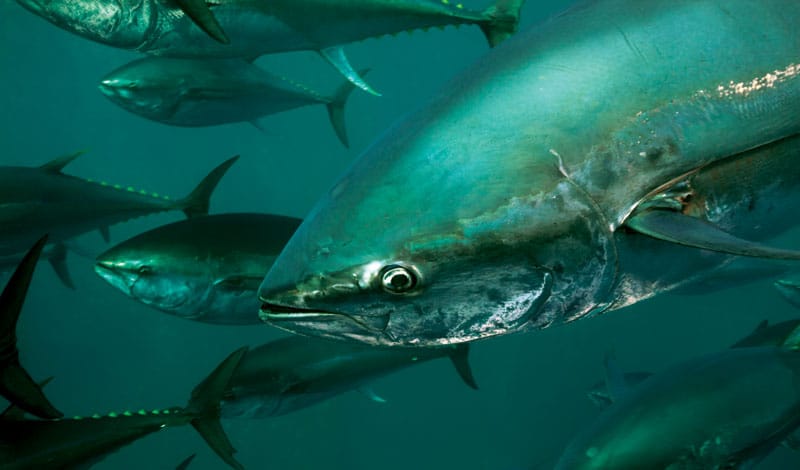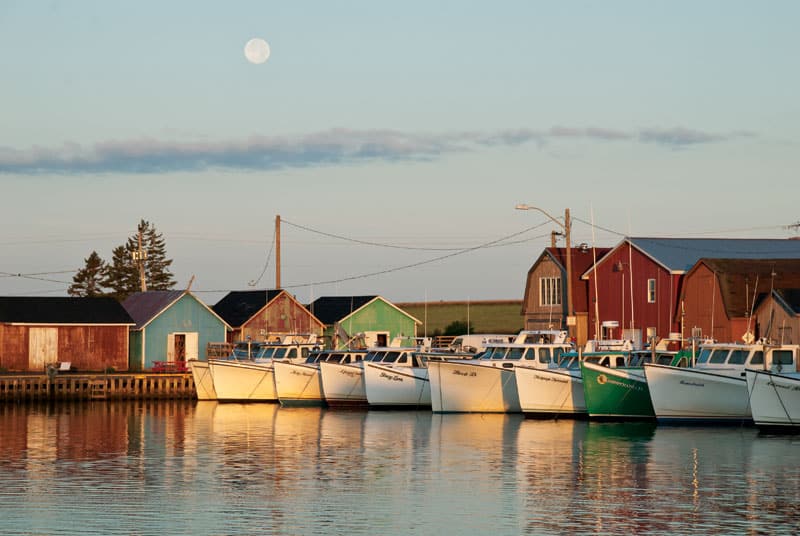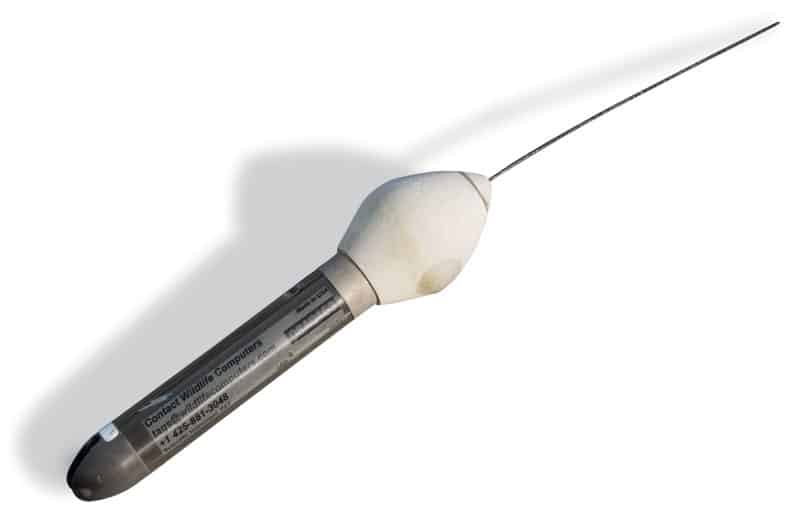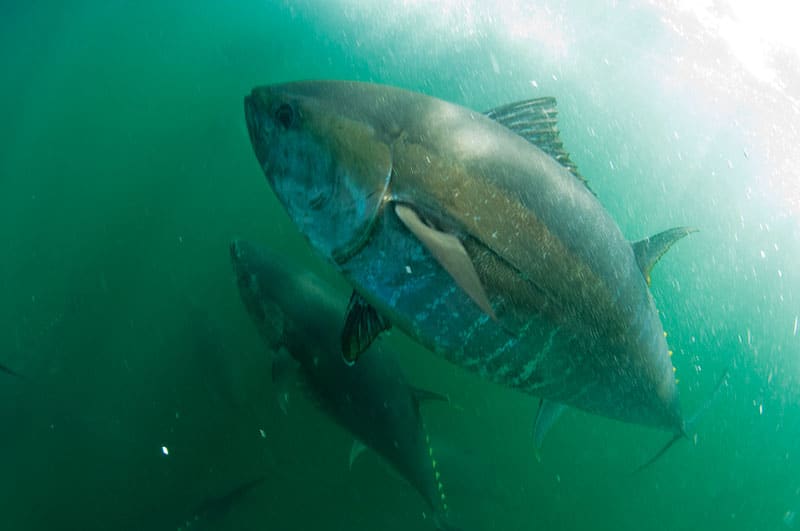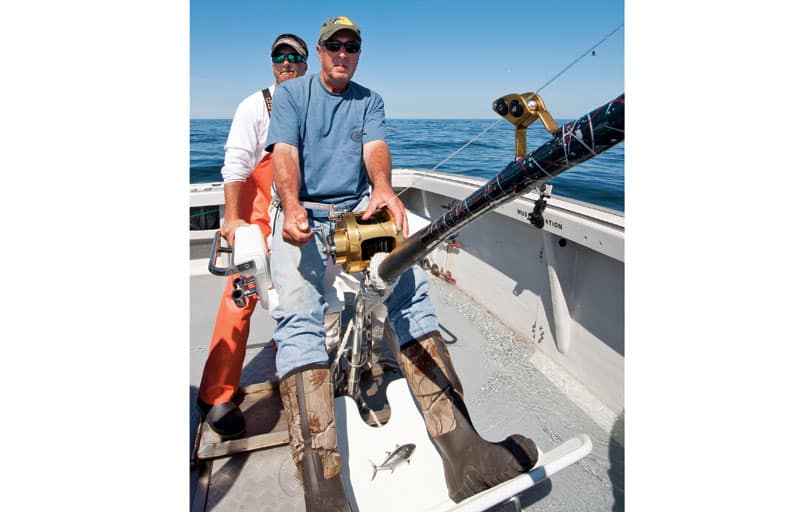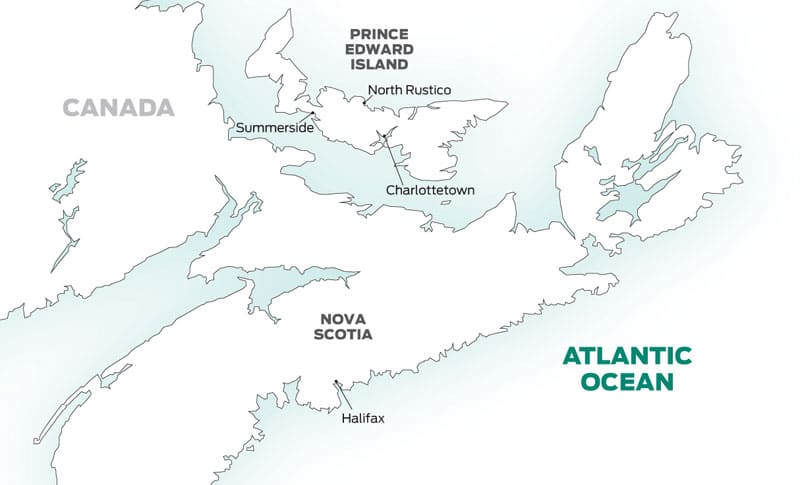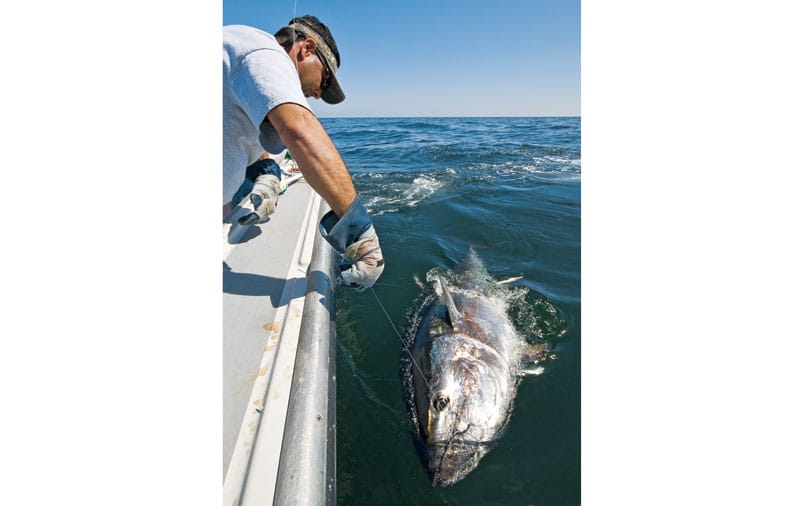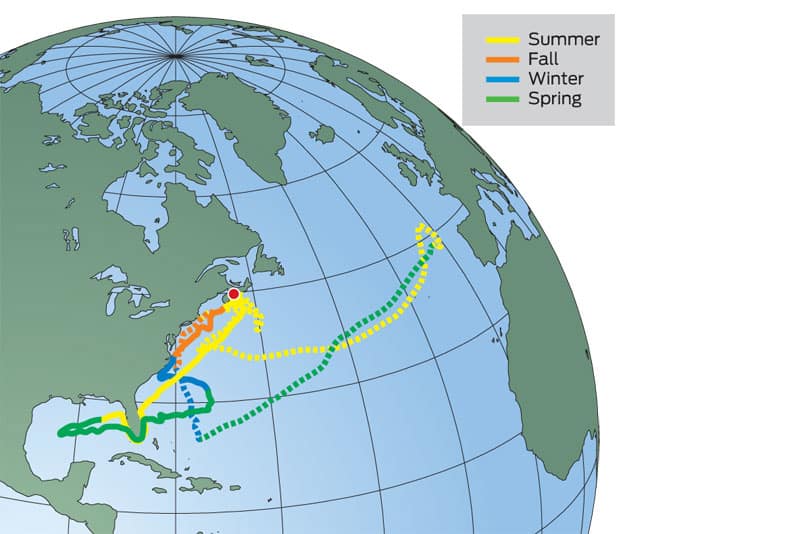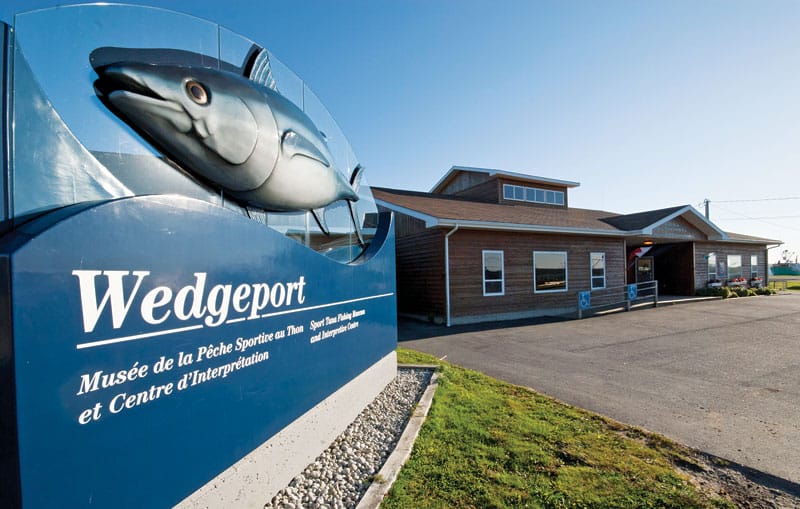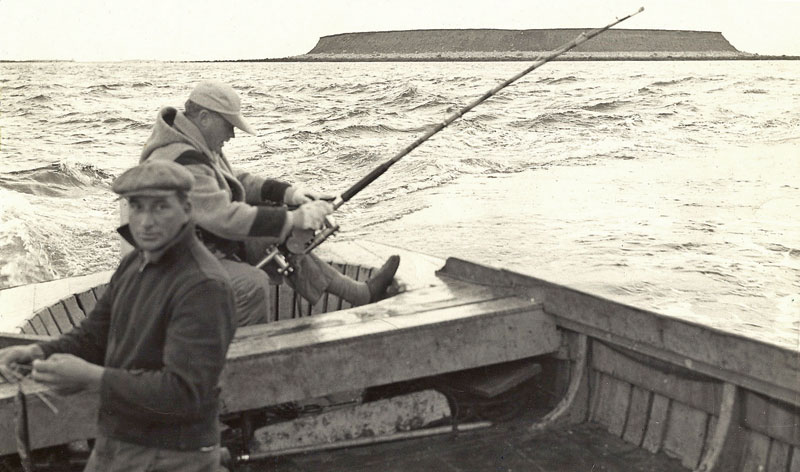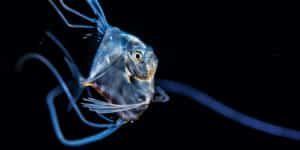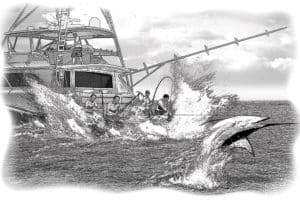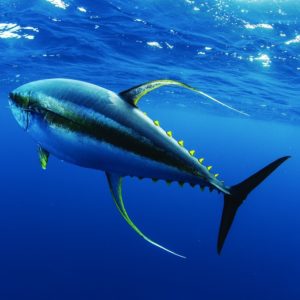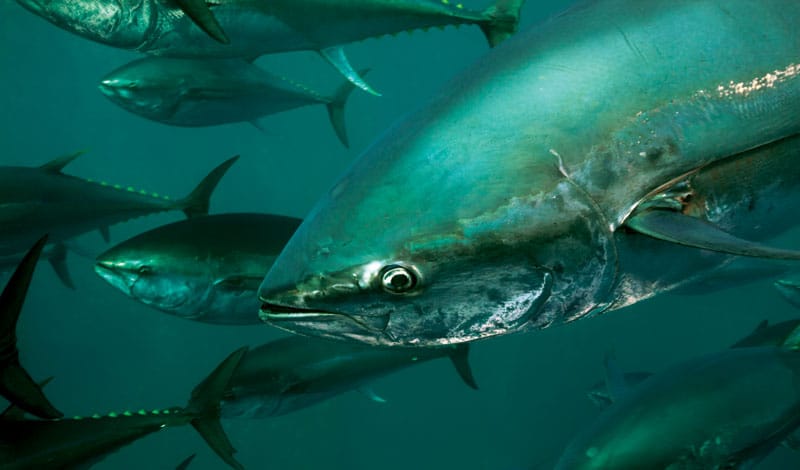
underwater bluefin
The Atlantic mackerel’s tail beat frantically on the water’s surface before it disappeared in the torrent of nearly seven feet of blitzing bluefin. When the tuna somehow missed the bait, Capt. Ewen Clark seemed grateful. “Get away!” he muttered over my shoulder to a fish clearly qualifying for “giant” status. “I saw that little fish roll on the bait and thought, ‘Don’t come back.’”
That attitude reflects the size of bluefin up here: In 17 years of commercial tuna fishing off Prince Edward Island, the smallest fish taken aboard Clark’s boat, Pura Vida, weighed 580 pounds. Bluefin in these waters average 700 pounds and nine feet long, and I soon found firsthand that they get much, much bigger.
But the real story in PEI isn’t just the size of bluefin tuna; these days, it’s that recreational anglers can fish for them at all.
In the 1970s, PEI’s busy charter fleet hung giant bluefin tuna on the dock so anglers could take photos. Then the worthless whole tuna carcasses were dumped at sea the next day. But by the mid-1980s, Japan’s taste for the fat-laden bluefin caught here had pushed prices upwards of $30 per pound.
This new industry brought ever-tightening government regulation and quotas, and made it illegal for anyone but commercial fishermen and scientists to hook bluefin tuna in Canada, even if the intention was to release the fish.
In just the past few years, a few fishermen and scientists worked to challenge long-held notions among both commercial fishers and biologists. Working together, they cut through government red tape and fishing politics to allow tightly controlled catch-and-release bluefin tuna charters off PEI.
Catching and Tagging Giants
“The power of a big tuna is unmatched. You can really feel that physical connection to the fish,” says Johnny Morris, the angler in Pura Vida’s fighting chair when the deep line came tight not long after that “little” 400-plus-pound tuna missed the kite bait. The fish that I saw eventually come alongside was both long and fat — weighing an estimated 1,200 pounds. “Once you get physically attached to powerful fish like that, it gets in your blood,” Morris says.
Morris, founder of Bass Pro Shops, is one of a select few outstanding anglers who fishes with Clark and Capt. Edward “Cookie” Murray to place pop-up satellite tags in giant bluefin off Prince Edward Island — until recently the only opportunity to fight and release bluefin here. Those tags, part of a study by the Large Pelagics Research Lab at the University of Massachusetts Amherst and the Department of Fisheries and Oceans Canada, record depth, salinity, temperature and light every few minutes. After a year, the tags float to the surface and transmit their data through satellites back to Lutcavage’s lab. These PSAT tags offered the first scientific hint that a catch-and-release charter fishery might work for giant bluefin.
“Cookie Murray has been handling these fish for decades,” says Dr. Molly Lutcavage, Large Pelagics Research Center director. “We worked with him to learn the techniques for tagging 900-pound fish in the water.” Unlike many other studies that capture fish with harpoon or purse seine and bring them aboard to tag, Lutcavage catches fish with rod and reel, and tags them while they swim alongside the boat. “Mortality rates are very low using our techniques,” she says. In 2001, new tags had the ability to show if fish died after tagging. Of the 350 of these “fail-safe” tags her team has placed, only two tuna have died.
Murray, who has targeted big-game fish around the world, insists none are equivalent to giant bluefin. “No matter how much we try to convey the strength of these fish, the pressure on the rod and angler, all that inevitably exceeds anglers’ expectations,” he says of even very experienced chair anglers who’ve not yet hooked a huge bluefin. Murray uses 30 to 45 pounds of drag, and at times 80 pounds. “The angler has to know when that line is going to break, exactly how much pressure he or she can put on the fish, and when and how to pump and wind,” he says.
To ensure each $4,500 tag pays off with data, Murray and Lutcavage’s other tagging crews in Nova Scotia also swim fish alongside the moving boat while inserting the tag. They remove barbless hooks and continue to tow the fish until it’s clearly recovered from the fight. The Large Pelagic Center’s tagging studies have huge implications for recreational fishermen. “Every study that uses fail-safe satellite tags is a post-release-mortality study,” Lutcavage says — the scientific measure of the success of catch-and-release angling.
Politics of Catch-and-Release Fishing for Bluefin
Late in the 1970s, before Canadian bluefin assumed their prime sushi status, the fish simply stopped coming to PEI. A common assumption is that a minor shift in the Gulf Stream brought cold water to the northeastern tip of Nova Scotia, blocking their route around to PEI. When the big bluefin came back a decade later, a few boats took charters during the commercial season, keeping both charter fees and the fish. But in following years, PEI’s tuna quota — and the time fishermen required to fill it — continually shrank as regulations tightened and fish became more plentiful.
“It’s just been the past few years that the fleet has been getting busier again as the number of tuna in the Gulf of St. Lawrence has really exploded,” says Capt. Jamie Gauthier of PEI’s Tuna Charter Boat Association. “With the commercial season being so short now — 38 hours in 2010 — we began running catch-and-release charters,” Gauthier says.
But nothing is simple with giant bluefin tuna. In 2008 and 2009, PEI’s charter association purchased quota from Newfoundland to account for the 18 percent of fish released by the charter fleet that the Canadian government assumed would die — an assumption based on studies of other species and in other locations. Last year that dropped to 11 percent, presumably because Lutcavage’s records showed extremely low mortality. Canada also set aside 10 metric tons of its total quota for catchandrelease charters and scientific tagging. Assuming 11 percent die, at PEI’s average of about 730 pounds, that’s just 275 tuna that the Canadian government will allow to be caught and then released.
Commercial fishermen are another obstacle. “There was a lot of talk that all the fish we released were dying,” Gauthier says of the fish released by charter skippers, which incited tension between charter and commercial captains.
Last summer, Dr. Michael Stokesbury of Acadia University and Dr. John Neilson with the Department of Fisheries and Oceans Canada worked with 20 PEI tuna fishermen to tag 59 fish with fail-safe satellite tags. Only two fish died — 3.4 percent — easing the minds of most commercial tuna men, and presumably adjusting mortality estimates for 2011. “There’s still opposition to catch-and-release, but people are realizing we’re not hurting the bluefin,” Gauthier says.
Meanwhile PEI’s commercial bluefin quota shrank from 250 metric tons in 2006 down to 126 tons for 2011. “The idea of charters is getting more popular,” he says.
Beginning this season, a few boats in northeastern Nova Scotia will also run catch-and-release bluefin charters. “One metric ton of tuna brings about $15,000 into the community,” says Dale Trenholm, vice president of Gulf Nova Scotia Charter Fishing Association. “Assuming 3.4 percent mortality, if we’re releasing one fish per day on charters, that same metric ton brings in at least $80,000. That’s just to fishermen, not the money spent at the airport and hotels and restaurants.” Yet like Gauthier, Trenholm has a hard time convincing his fellow commercial fishermen of the value of charters.
Canadian Tuna Charters
Commercial fishermen in PEI and Nova Scotia earn most of their income lobstering. Charter boats are well kept and comfortable, but they’re still single-engine lobster boats with some added safety gear. Private boats aren’t allowed in the fishery, and PEI has some unusual restrictions on charters. Each boat can release only one fish in a day. Fight times are kept shorter than 90 minutes, even if that means the mate finishes the fight. Canadian DFO rigid-hull inflatables monitor the fleet off PEI closely.
Of PEI’s 17-boat charter fleet, only Clark’s boat had a fighting chair as of last summer. Four or five more boats are expected to install chairs this summer. Another half-dozen boats provide stand-up gear, spooled with the government-required minimum of 130-pound-test, though many fish 200-pound-test line.
The few boats running out of northeast Nova Scotia fish by the same rules in the same waters, and some already have fighting chairs installed. (Northumberland Strait, which separates the two provinces, is only 14 miles wide.) In fact, it was a boat out of Nova Scotia fishing here that landed the IGFA all-tackle-record 1,496-pound Atlantic bluefin tuna in 1979.
Tuna arrive in PEI waters late in July, and most boats won’t run charters much past Halloween. Clark says August provides the best weather, but occasional storms in September and October move through quickly, and the Gulf of St. Lawrence — only 150 miles across — quiets overnight. Those willing to risk an occasional rough day will find bigger fish in the fall, Clark says: “That 1,200-pound fish, I don’t know what it would have weighed after two months of a bellyful of herring.”
Southern Nova Scotia Tuna
Capt. Eric Jacquard also tags fish with Lutcavage. His boat, Fin Seeker sails from Wedgeport, Nova Scotia. The first giant tuna were caught here on the southwest coast of Nova Scotia, including Zane Grey’s then-record 758-pounder in 1924. In 1935, International Game Fish Association founder Michael Lerner, together with legendary captain Tommy Gifford, battled massive tuna on Soldier’s Rip, just yards from Wedgeport’s shores. Beginning in 1937, the International Tuna Cup Match drew President Franklin Roosevelt, Amelia Earhart, singers, actors, adventurers — Wedgeport was the center for huge tuna fishing.
Then in 1950, tuna catches declined sharply. “They built the causeway out to Cape [Sable] Island in 1949,” says Capt. Louis Boudreau. “The next year the herring went ashore and died by the thousands,” he says of the mile-long strip of land blocking water once open to the tide. The tuna left Soldier’s Rip, and the tournament lost its luster.
But bluefin tuna were still around. “A lot of boats were going offshore swordfishing, harpooning. We saw schools of tuna out there,” says Capt. Ernie Porthier, another old hand out of Wedgeport. But tuna weren’t worth pursuing: “The last year I harpooned one, we got 10½ cents per pound.”
Nova Scotia Recreational Angling Today
Currently the only opportunities to catch tuna in southern Nova Scotia are during the Wedgeport Tuna Tournament in mid-August, or another tournament in Halifax toward the end of September. Charters are available for the tournaments, and both allow international yachts to participate — the only opportunity for private boats to fish for Canadian bluefin tuna. Currently, the Halifax tournament lands only the first 10 bluefin caught, without selectively releasing smaller fish. In the Wedgeport tournament, each boat can land only one bluefin.
Can Bluefin Stocks Support Catch-And-Release Fishing?
The more that’s learned about bluefin tuna, the more that scientists realize they don’t know. For example, Lutcavage’s team tagged juvenile bluefin off the Carolinas and Virginia, and Dr. Haritz Arrizabagala’s team tagged bluefin of similar size off the north coast of Spain. Both stocks ended up feeding in the same waters south of the Grand Banks. This challenges the long-held notion that eastern and western Atlantic stocks — and particularly juvenile fish — seldom mix. “Satellite tags tell us where the fish are beyond where the fleet is operating,” Lutcavage says.
Much scientific data on bluefin tuna is based on commercial-fishing statistics. Yet this data is often skewed by economics. Before each commercial-fishing trip, Capt. Jacquard must notify Canada’s Department of Fisheries and Oceans. “When I hail out for a seven- or 10-day swordfish trip, I’ll also hail out for tuna. If it’s a slow trip for swordfish, we might take a few tuna to fill in,” Jacquard says. “The scientists see a 10-day trip with two tuna, or no tuna if swordfishing was good, when we targeted tuna for an hour, four hours, maybe even just 10 minutes.”
Lutcavage questions current bluefin stock assessments based on data obtained through commercial-fishing catches. “From spotter planes, we see very large surface biomasses of fish in the Gulf of Maine, even on days when fishermen are not landing fish,” she says. Her team has developed aerial survey techniques combined with simultaneous side-scan sonar images of a school to accurately estimate both the size of the school and the size of the fish within it. “There is evidence of large numbers of fish, both giants and juveniles, in the northwest Atlantic.” Assuming compliance with ICCAT management objectives, Lutcavage says, “We’re confident in saying we don’t think bluefin tuna are on the edge of extinction.”
Moving Forward
Lutcavage’s research is helping to prove the value of catch-and-release bluefin charters, which is helping fishermen. Gauthier is hoping to use a portion of PEI’s charter-association funds to buy some of the more than 300 commercial-tuna licenses on the island that the steadily shrinking commercial quota won’t support. Based on early success in PEI, Jacquard feels he is finally close to cutting through government red tape to begin a viable charter industry in southwest Nova Scotia.
Lutcavage is collecting data independent from commercial fisheries. Ironically, she does so by teaming up with commercial and recreational fishermen. “Early bluefin researchers always worked with fishermen, both commercial and recreational. Getting away from that led us to depend more on catch statistics and less on biology,” Lutcavage says. “Now we’re coming back to it.”
Morris appreciates just being out there as part of nature, among whales and seals, and with the chance of releasing a huge tuna. He battled a true giant and won, but then let it go. “It’s a neat thing to see that fish swim off like that, especially with that tag in it,” Morris says.
Visiting PEI and Nova Scotia
Prince Edward Island’s rolling green hills, red-sand beaches and the warm water of the Gulf of St. Lawrence attract summertime family vacationers. The island is shaped like a crooked smile spanning 175 miles from tip to tip. Tuna charters depart from several harbors along the north coast, so inquire about nearby accommodations while planning a trip.
Charlottetown is the birthplace of Canadian independence on July 1, 1867 — called Confederation. Much of its downtown dates back to British colonial days. Check out Victoria Row for dining. Summerside doesn’t have the rich history and isn’t quite as upscale, but it’s much closer to the majority of charters while still offering city amenities. The villages of North Rustico and Cavendish, both about in the middle of the north coast, are closest to fishing. Each has a few good restaurants as well as cottages to rent and inns.
Delta offers two-and-a-half-hour flights from New York City directly to Charlottetown Airport. PEI is about a 10-hour drive from Boston on interstate highways and across an eight-mile-long toll bridge.
Nova Scotia’s rocky southwestern coast is beautiful, but sees fewer tourists than PEI. The closest accommodations, in Yarmouth, are 20 minutes from Wedgeport by car. Yarmouth has lost a bit of luster since the heyday of the Tuna Tournament. The upscale Trout Point Lodge is about 45 minutes north of Wedgeport.
Halifax is the largest city in the region, with lots to do along a half-mile section of the city’s waterfront. If making the four-hour drive to Wedgeport to visit the Tuna Museum, consider stopping in Lunenburg, Chester or Shelburne along the way.
Halifax airport is two hours from New York by air. The drive From Boston is seven hours to Saint John, and then a three-hour ferry ride across the Bay of Fundy, and another two-and-a-half-hour drive to either Wedgeport or Halifax.
CONTACTS
Prince Edward Island (www.tourismpei.com)
Fishing
Prince Edward Island Tuna Charter Boat Association; www.peituna.com
(under construction at press time)
Joey or Jamie Gauthier; www.joeysfishing.com
Ewen Clark, contact through charter association website
Accommodations
Summerside
Loyalist Lakeview Resort, 902-436-3333; www.lakeviewhotels.com
Charlottetown
Delta Prince Edward, 902-566-2222; www.deltahotels.com
Rodd Charlottetown, 902-894-7371; www.roddhotelsandresorts.com
(Rodd offers several resorts on PEI.)
North Coast
Chalets on the Clyde cottages, 866-963-3838; www.chaletsontheclyde.com
Blue Crest Cottages, 800-852-6656; www.bluecrestcottages.com
For rental properties islandwide, check peivacationrentals.com
Nova Scotia (www.novascotia.com)
Fishing
Halifax International Tuna Tournament, 902-830-7727; www.nstuna.ca
Zappa Charters, Dale Trenholm, 902-386-2669; www.zappacharters.com
For charter information for either tournament, contact Gwen or Kathy at the Wedgeport Sport Tuna Fishing Museum; 902-663-4345, www.wedgeporttunamuseum.com
Accommodations
Northeast Nova Scotia
www.zappacharters.com
Wedgeport
Rodd Grand Yarmouth Hotel, 902-742-2446; www.roddhotelsandresorts.com
Trout Point Lodge, 902-482-8360; www.troutpoint.com
Halifax
Delta Halifax Hotel, 902-425-6700; www.deltahalifax.com
Charter prices begin around $1,000 for a 10-hour day, though boats might come in early with the one-fish limit. Boats with chairs charge more; typically $2,000 to $3,000 per day, with all-inclusive packages, including airport and daily transportation, lodging and all meals.
